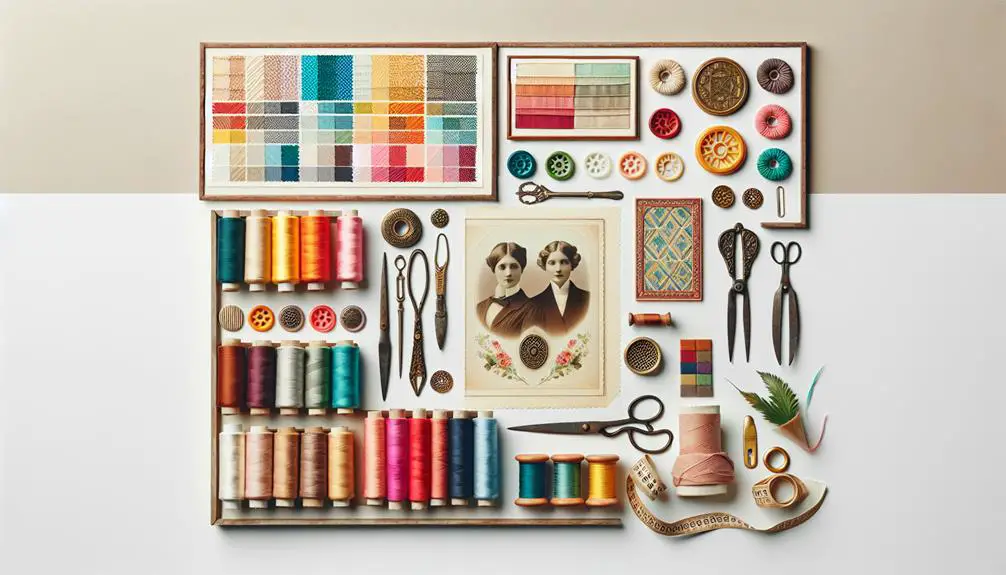You might not realize it, but William Morris' designs were originally part of a broader movement to bring art into everyday life. His intricate botanical patterns have since become iconic, influencing countless designers. Coco Chanel's revolutionary use of jersey fabric and her creation of the Little Black Dress pushed fashion boundaries and redefined elegance. Meanwhile, Marimekko's bold prints have empowered individuals with their vibrant energy. Vera Neumann's whimsical patterns added a touch of sophistication to daily items, and Alexander McQueen's provocative designs embedded rich narratives into his textiles. Curious about how these designers have shaped the industry?
Table of Contents
Key Takeaways
- William Morris revolutionized fabric design with intricate, nature-inspired patterns emphasizing handcrafted quality over mass production.
- Coco Chanel popularized jersey fabric for women's fashion and introduced iconic designs like the Little Black Dress and tweed suits.
- Marimekko is renowned for bold patterns and vibrant colors, empowering individuals with timeless, artistic designs.
- Vera Neumann adapted screen printing for mass production, creating vibrant, whimsical patterns and iconic scarves representing elegance and creativity.
- Alexander McQueen's daring designs showcased fabric manipulation and dramatic narratives, significantly influencing high fashion with collections like 'Highland Rape' and 'Plato's Atlantis'.
William Morris
William Morris, a pivotal figure in the Arts and Crafts movement, revolutionized fabric design with his intricate patterns and commitment to craftsmanship. By emphasizing handcraft over mass production, Morris's influence reshaped the textile industry. His designs, often inspired by nature, featured intricate botanical patterns that continue to captivate.
You can't overlook how Morris's textile prints brought a new level of sophistication and artistry to fabric design. His meticulous approach to creating patterns meant every piece was a work of art. When you study his designs, you'll notice how he combined rich colors with detailed motifs, creating textiles that were both visually stunning and deeply functional.
Morris's influence extends beyond just the aesthetic. He advocated for the value of handcrafted goods in an era increasingly dominated by industrialization. By doing so, he not only preserved traditional crafts but also elevated them to new heights.
When you incorporate Morris's principles into your own work, you're embracing a legacy of quality, beauty, and purpose. Whether you're designing your own fabrics or appreciating his timeless prints, understanding Morris's impact will unquestionably elevate your mastery in the world of textile design.
Coco Chanel
Coco Chanel revolutionized fabric design by introducing innovative textiles and timeless styles that continue to influence fashion today. Her approach to fashion was nothing short of groundbreaking, combining comfort with elegance, and practicality with luxury. Chanel's vision redefined what it means to be a fashion icon, and her impact is still felt in modern fashion circles.
To truly understand Chanel's contributions, consider these four key innovations:
- Jersey Fabric: Chanel popularized the use of jersey, a material previously relegated to men's underwear, for chic women's clothing, making it a staple of comfortable yet stylish attire.
- Little Black Dress: She introduced the Little Black Dress in 1926, a simple yet sophisticated design that epitomizes timeless elegance and remains a wardrobe essential.
- Tweed Suits: Chanel's tweed suits, first introduced in the 1920s, combined masculine and feminine elements, offering women both style and comfort in professional settings.
- Costume Jewelry: She broke the norm by pairing high fashion with faux pearls and costume jewelry, making luxury accessible to a broader audience.
Marimekko
Few brands have left as vibrant a mark on fabric design as Marimekko, known for its bold patterns and innovative use of color. When you think of Scandinavian design, Marimekko's colorful patterns and bold prints probably come to mind. Since its founding in 1951, Marimekko has been a pioneer in transforming everyday items into pieces of art, embodying a timeless style that resonates across generations.
Marimekko's iconic designs, such as the Unikko (poppy) pattern, have made a significant impact on fashion and home decor. These designs are not just visually appealing; they also embody a sense of optimism and creativity. The brand's philosophy focuses on empowering individuals to express themselves freely through vibrant, fearless designs.
| Pattern Name | Designer |
|---|---|
| Unikko | Maija Isola |
| Kaivo | Maija Isola |
| Kivet | Maija Isola |
| Räsymatto | Maija Louekari |
Vera Neumann
Vera Neumann, an American artist and entrepreneur, revolutionized fabric design with her vibrant and whimsical patterns that continue to inspire designers today. You can't talk about textile innovation without mentioning Vera Neumann's iconic scarves. These scarves, often adorned with bold florals and abstract designs, became a symbol of elegance and creativity. They weren't just accessories; they were pieces of art you could wear.
Vera Neumann's impact on the textile industry can't be overstated. She was a pioneer who broke the mold and created new standards. Here are four ways she made her mark:
- Innovative Printing Techniques: Vera adapted screen printing for fabric, allowing for the mass production of her intricate designs.
- Signature Style: Her unique use of color and pattern created a recognizable brand, making her work instantly identifiable.
- Cross-Disciplinary Influence: Vera's designs transcended textiles, influencing home décor, fashion, and even fine art.
- Empowering Women: As a successful female entrepreneur in the mid-20th century, she paved the way for future generations of women in design and business.
Alexander McQueen
Moving from the vibrant and whimsical world of Vera Neumann, you encounter the dramatic and provocative designs of Alexander McQueen. Known for his daring approach, McQueen spearheaded a fashion revolution that forever altered the landscape of high fashion. His runway creativity combined with his mastery of fabric manipulation made each collection a bold statement.
When you explore McQueen's work, you witness an unparalleled blend of artistry and technical prowess. He was a maestro who transformed textiles into vessels of storytelling, embedding them with rich narratives and emotional depth. McQueen's designs often featured a dark romanticism, seamlessly merging historical references with futuristic visions.
Here's a snapshot of McQueen's standout contributions:
| Year | Collection | Signature Element |
|---|---|---|
| 1995 | 'Highland Rape' | Distressed tartan fabric |
| 1999 | 'No. 13' | Robotic spray-painting on the runway |
| 2001 | 'Voss' | Enclosed glass box, mental asylum theme |
| 2006 | 'Widows of Culloden' | Holographic projection of Kate Moss |
| 2010 | 'Plato's Atlantis' | Digital prints and marine-inspired forms |
McQueen's legacy is one of fearless innovation. His work didn't just adorn the body; it challenged perceptions and redefined the boundaries of fashion. For anyone seeking mastery in design, studying McQueen is an essential journey into the heart of fashion's transformative power.
Frequently Asked Questions
What Are the Common Types of Fabric Used in High Fashion?
You'll often find high fashion using silk satin for its luxurious sheen and velvet corduroy for its rich texture. These fabrics elevate designs, making them exquisite and sophisticated, perfect for those who appreciate high-quality garments.
How Do Fabric Trends Influence Interior Design?
Imagine the suspense in choosing the perfect fabric. Fabric trends directly shape interior design by blending color psychology with texture impact, drawing on historical influences, and adding modern twists that create both harmony and excitement in your space.
What Role Does Sustainability Play in Fabric Design Today?
In today's fabric design, you're prioritizing eco-friendly practices and ethical sourcing. These steps reduce environmental impact and guarantee fair labor conditions. Your commitment to sustainability reflects a deeper understanding of responsible and innovative design.
How Can One Start a Career in Textile Design?
To start on your textile design career, embrace a Renaissance mindset. Pursue textile design education, and immerse yourself in the creative process. Build a strong portfolio, network with industry professionals, and stay updated on emerging trends.
What Are the Key Differences Between Digital and Traditional Fabric Printing?
You'll find that digital printing offers superior color accuracy and versatility. It's also more cost-efficient and faster. Traditional printing, though, excels in texture and tactile quality but often lags in speed and versatility.
- How to Care for Your Nonwoven Polypropylene Tote Bags - July 11, 2025
- Understanding SMS, SMMS, and SMMMS Nonwoven Composites - July 11, 2025
- The Ultimate Guide to Spunbond Nonwoven Fabrics - July 11, 2025







